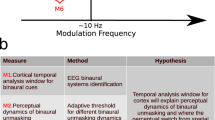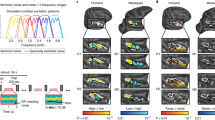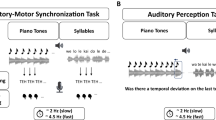Abstract
Despite growing interest in temporal aspects of auditory neural processing1,2, little is known about large-scale timing patterns of brain activity during the perception of auditory sequences3. This is partly because it has not been possible to distinguish stimulus-related activity from other, endogenous brain signals recorded by electrical or magnetic sensors. Here we use amplitude modulation of unfamiliar, ∼1-minute-long tone sequences to label stimulus-related magnetoencephalographic neural activity in human subjects4,5,6,7,8,9. We show that temporal patterns of activity recorded over particular brain regions track the pitch contour of tone sequences, with the accuracy of tracking increasing as tone sequences become more predictable in structure. In contrast, temporal synchronization between recording locations, particularly between sites over the left posterior hemisphere and the rest of the brain, is greatest when sequences have melody-like statistical properties10,11, which may reflect the perceptual integration of local and global pitch patterns in melody-like sequences12. This method is particularly well suited to studying temporal neural correlates of complex auditory sequences (such as speech or music) which engage multiple brain areas as perception unfolds in time.
This is a preview of subscription content, access via your institution
Access options
Subscribe to this journal
Receive 51 print issues and online access
$199.00 per year
only $3.90 per issue
Buy this article
- Purchase on Springer Link
- Instant access to full article PDF
Prices may be subject to local taxes which are calculated during checkout



Similar content being viewed by others
References
Cariani, P. A. & Delgutte,, B. Neural correlates of the pitch of complex tones. I. Pitch and pitch salience. J. Neurophysiol. 76, 1698–1716 ( 1996).
deCharms, R. C. & Merzenich, M. Primary cortical representation of sounds by the coordination of action potential timing. Nature 381, 610–613 ( 1996).
Petsche, H., Richter,, P., von Stein, A., Etlinger, S. & Filz, O. EEG coherence and musical thinking. Music Percept. 11, 117– 152 (1993).
Galambos, R., Makeig, S. & Talmachoff, P. J. A 40-Hz auditory potential recorded from the human scalp. Proc. Natl Acad. Sci. USA 78, 2463 –2647 (1981).
Romani, G. L., Williamson, S. J. & Kaufman, L. Tonotopic organization of the human auditory cortex. Science 216, 1339–1340 (1982).
Pantev, C. et al. Relationship of transient and steady-state auditory evoked fields. Electroenceph. Clin. Neurophysiol. 88, 389–396 (1993).
Hari, R. Hämäläinen, M. & Joutsiniemi,, S. -L. Neuromagnetic steady-state responses to auditory stimuli. J. Acoust. Soc. Am. 86, 1033–1039 ( 1989).
Gutschalk, A. et al. Deconvolution of 40 Hz steady-state fields reveals two overlapping source activities of the human auditory cortex. Clin. Neurophysiol. 110, 856–868 ( 1999).
Makeig, S., Jung, T-P., Bell, A. J., Ghahremani, D. & Sejnowski, T. J. Blind separation of auditory event-related brain responses into independent components. Proc. Natl Acad. Sci. USA 94, 10979–10984 ( 1997).
Nettheim, N. On the spectral analysis of melody. Interface 21, 135–148 (1992).
Boon, J. P. & Decroly, O. Dynamical systems theory for music dynamics. Chaos 5, 501– 508 (1995).
Liégeois-Chauvel, C., Peretz, I., Babaı ¨, M., Laguitton, V. & Chauvel, P. Contribution of different cortical areas in the temporal lobes to music processing. Brain 121, 1853–1867 (1998).
Schmuckler, M. A. & Gilden., D. L. Auditory perception of fractal contours. J. Exp. Psychol.: Hum. Percept. Perform. 19, 641–660 (1993).
Voss, R. F. & Clarke, J. ‘1/f noise’ in music and speech. Nature 258, 317– 318 (1975).
Voss, R. F. & Clarke, J. ‘1/f noise’ in music: music from 1/f noise. J. Acoust. Soc. Am. 63, 258–263 (1978).
Siegel, S. & Castellan, N. J. Jr Nonparametric Statistics for the Behavioral Sciences (McGraw Hill, New York, 1988).
Greenberg, S., Poeppel, D. & Roberts,, T. in Psychophysical and Physiological Advances in Hearing (eds Palmer, A., Summerfield, Q., Rees, A. & Meddis, R.) 293–300 (Whurr, London, 1998).
Srinivasan, R., Russell, P., Edelman, G. & Tononi, G. Increased synchronization of neuromagnetic responses during conscious perception. J. Neurosci. 19, 5435–5448 ( 1999).
Zatorre, R. J., Evans, A. C. & Meyer, E. Neural mechanisms underlying melodic perception and memory for pitch. J. Neurosci. 14, 1908– 1919 (1994).
Patel, A. D., Peretz, I., Tramo, M. & Labrecque, R. Processing prosodic and musical patterns: a neuropsychological investigation. Brain Lang. 61, 123–144 ( 1998).
Pantev, C., Roberts, L. E., Elbert, T., Roβ, B. & Wienbruch, C. Tonotopic organization of the sources of human auditory steady-state responses. Hearing Res. 101, 62–74 ( 1996).
Ribary, U. et al. Magnetic field tomography of coherent thalamocortical 40-Hz oscillations in humans. Proc. Natl Acad. Sci. USA 88 , 11037–11041 (1991).
Bendat, J. S. & Piersol, A. G. Engineering Applications of Correlation and Spectral Analysis (Wiley, New York, 1993).
Acknowledgements
We thank L. Kurelowech for technical assistance, R. Srinivasan for advice and discussions, and S. Makeig, M. Kutas, T. Urbach and S. Hillyard for suggestions. This research was supported by the Neurosciences Research Foundation as part of its research program on Music and the Brain at The Neurosciences Institute.
Author information
Authors and Affiliations
Corresponding authors
Supplementary Information
Rights and permissions
About this article
Cite this article
Patel, A., Balaban, E. Temporal patterns of human cortical activity reflect tone sequence structure . Nature 404, 80–84 (2000). https://doi.org/10.1038/35003577
Received:
Accepted:
Issue Date:
DOI: https://doi.org/10.1038/35003577
This article is cited by
-
1/f laws found in non-human music
Scientific Reports (2023)
-
Scaling behaviour in music and cortical dynamics interplay to mediate music listening pleasure
Scientific Reports (2019)
-
A combinatorial framework to quantify peak/pit asymmetries in complex dynamics
Scientific Reports (2018)
-
Synchronized retinal oscillations encode essential information for escape behavior in frogs
Nature Neuroscience (2005)
-
Spatiotemporal characteristics of the neural activities processing consonant/dissonant tones in melody
Experimental Brain Research (2005)
Comments
By submitting a comment you agree to abide by our Terms and Community Guidelines. If you find something abusive or that does not comply with our terms or guidelines please flag it as inappropriate.



